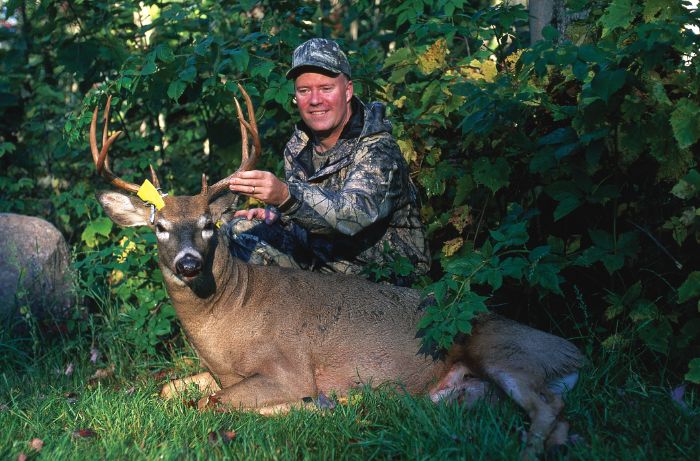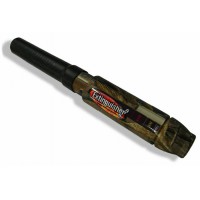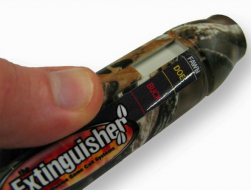
In the last 30 years no topic has received as much ink as deer calling. A hunter would be pretty confused if he believed everything he read. There’s a reason for all that confusion: Some folks make money selling deer calls, and they continually have to come up with new angles and new products to keep themselves in the black. Don’t read this wrong: Deer calling is a legitimate, and effective, way to hunt deer. However, truth be known, it’s the simplest of wildlife calling methods. Calling to a white-tailed deer is not nearly as complicated as, say, calling wild turkeys, ducks, geese or coyotes.
To enjoy success while calling, a hunter needs to keep an open mind. Deer typically don’t spook from loud calling unless it’s accompanied by other stimuli, such as human scent or movement. Master a few of the basic sounds, and you’ll be prepared to hunt with more confidence.

GET A DEAL ON THE EXTINGUISHER DEER CALL
When I was younger, I never had much luck in calling deer, but my attitude changed in the late 1990s when I shared a November gun-hunt with my dad. We were hunting a large rye field that bordered a creek, and he had taken a stand along the field’s edge about 300 yards to the south of my ground blind. After hunting nearly all day without seeing much, I pulled out my grunt call to see if I could lure a deer out of the creek bottom. I put the call to my lips and let out three super-loud grunts. I waited a few minutes and repeated the process, this time adding an extended snort-wheeze. I put the call down and waited 10 minutes. Nothing happened, so I shoved the call into my coat pocket and watched the desolate field until closing time.
While walking back to my pickup truck, I noticed my dad was walking faster than normal to greet me. He closed within 50 yards, then started waving his arms and placing his hands over his head and spread his fingers to resemble antlers. “Didn’t you see him?” he gasped. “See what?” I replied. “Oh, man! A huge 10-pointer came to the edge of the field when you called that second time!”
“You could hear me?” I replied, astonished. “Like a bell,” Dad said. “That buck stood there and stared at your ground blind for at least 10 minutes. He eventually turned and walked back into the brush.”
Needless to say, I was heartbroken. The buck was only 150 yards from my gun barrel and I never saw him. He might have easily stepped into the open had I been persistent and stuck with my calling plan — and maybe even threw in a snort wheeze or a growl, bawl or roar. I knew better than to call blindly and give up after just two attempts. Calling success requires patience and persistence. By caving into a common deer-calling myth – always call sparingly – I possibly blew the chance of a lifetime.
That hunt also debunked the other common deer calling myth that loud calls will always spook deer. It didn’t spook that deer; it piqued his curiosity. Heck, I blew that call so loud that my dad could hear it all the way across a 40-acre field! Deer hear thousands of sounds every day, and many of them are loud … trains, lawnmowers and even exploding artillery. They’re usually not spooked by loud noises, unless, as mentioned, they’re accompanied with another stimuli. When they are spooked, they often don’t flee immediately. Instead, they typically circle downwind of the source so they can scent-check it.
“When I hear that (myth), it just irks me, because it’s totally way off,” legendary whitetail hunter Brad Harris once told me. “Every situation is different. You have to match your calling with the terrain and conditions.”
Some hunters have also claimed that deer can readily decipher tones and determine which calls come from bucks and which ones come from does. Again, that’s purse nonsense. With the exception of fawn bleats, deer cannot use sounds alone to identify strangers in their midst.
“A buck doesn’t have the capacity to hear a sound and then think to himself, ‘Oh, that was a yearling buck,’ or ‘That was a 3-year-old buck.’ He needs to see the other deer,” Harris added. A doe’s grunt is usually lower in pitch than a buck’s, but not always.
Another Myth A fourth myth involves when to stop calling. Many seasoned hunters claim that you should always stop calling once you have a deer’s attention. As evidenced in the aforementioned hunt, that’s a big mistake. Deer are good listeners, not great ones.
“You have to back up that first call with another one if the buck hasn’t committed to coming your way,” Harris said. “I can’t count the number of deer that I’ve killed by following up with a call once I’ve gotten their attention. That follow-up call is often the difference between a close encounter and one that puts the deer in shooting range.”
Finally, some hunters and outdoor writers have stated the secret to deer calling is a tactic any average hunter can use all season to dupe wary whitetails. If that’s the case, I’m a well-below-average deer hunter. Making the sounds might be easy enough, but it takes an extremely skilled hunter to dupe pressured whitetails during the early and late seasons. Calling requires common sense and a realistic approach. Use aggressive tactics during the rut, and save the subtle tactics for the pre- and post-rut periods.
POPULAR CALL ON SALE NOW

The Extinguisher™ Deer Call is the only deer call that sounds like a buck, doe and fawn in an instant. Thanks to the Extinguisher’s patented Modislide™ System and FreezeFree™ design it’ll work in all weather conditions throughout the season
The Extinguisher Deer Call comes with Illusion’s in-depth instructional DVD. Olympic gold medalist Rod White will show you how to better communicate with whitetail deer. This hour long production also includes live video segments of whitetail deer vocalizations and behavior so you can see exactly what you need to sound like when using your call in the field.











































